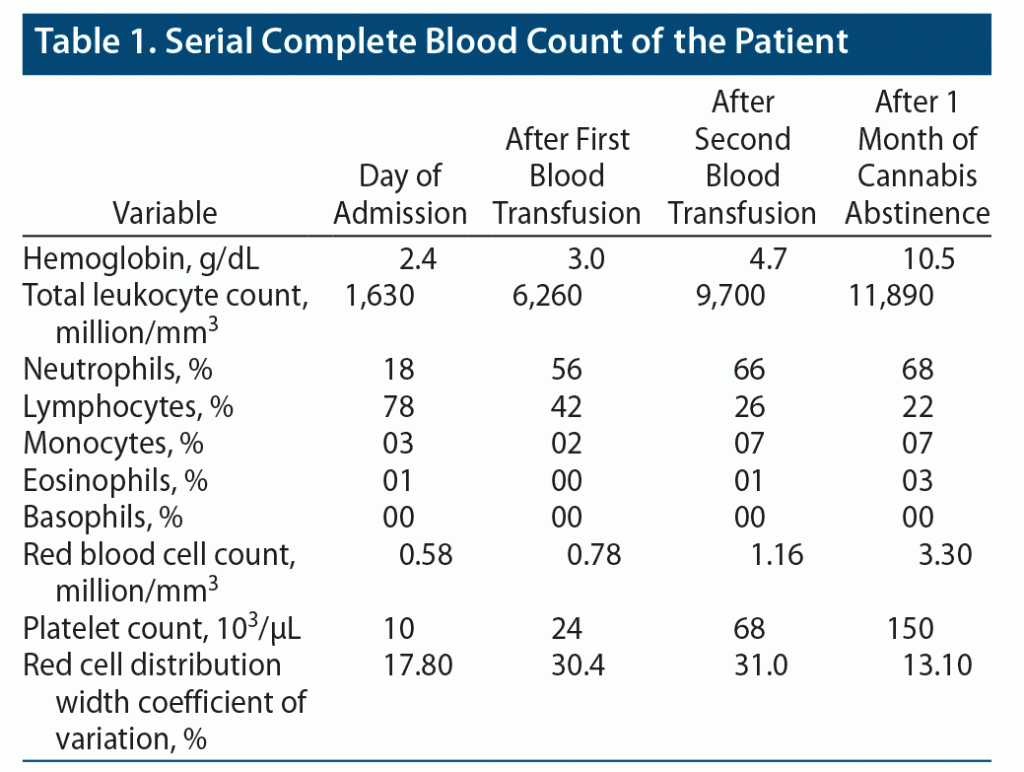
Prim Care Companion CNS Disord 2022;24(5):21cr03155
To cite: Tyagi P, Garg S, Khattri S, et al. Cannabis-induced pancytopenia. Prim Care Companion CNS Disord. 2022;24(5):21cr03155
To share: https://doi.org/10.4088/PCC.21cr03155
© 2022 Physicians Postgraduate Press, Inc.
aDepartment of Psychiatry, Shri Guru Ram Rai Institute of Medical and Health Sciences, Dehradun, Uttarakhand, India
bDepartment of Psychiatry, AIIMS, Bibinagar, Telangana, India
*Corresponding author: Shobit Garg, MD, DPM, Department of Psychiatry, Shri Guru Ram Rai Institute of Medical and Health Sciences, Patel Nagar, Dehradun, Uttarakhand, India 248001 ([email protected]).
Pancytopenia is an important clinical-hematologic entity in which all 3 major elements of blood lineage, namely red blood cells, white blood cells, and platelets, are decreased in number. Pancytopenia results from several disease processes either primarily or secondarily involving the bone marrow.1 Cannabis is derived from Cannabis sativa. Its active compound is known as cannabinoid (CB).2 CB ligands bind with specific G-protein–coupled receptors, ie, CB1 and CB2, and influence the central nervous and blood cell lineage (immune system) systems, respectively.2 There has been a dearth of studies addressing the morbid effects of cannabis abuse on the hematopoietic system. We report a rare case of cannabis-associated pancytopenia.
Case Report
A 27-year-old man presented to the emergency department with altered mental status and cannabis overdose. He gave a history of weakness and breathlessness for the past few weeks. He reported a daily intake of 10–12 joints of cannabis for the last 7 years. Except for cigarette smoking for the last 14 years, intake of other substances or drugs was denied. Past medical, surgical, and family history was insignificant.
On physical examination, his vitals were stable, and pallor was present, with no stigmata of bleeding, lymphadenopathy or hepatosplenomegaly, or sensory-neural deficits. The initial biochemistry results revealed that all of his cell counts were low (Table 1). Liver, renal, and thyroid functions were within normal limits. Bone marrow biopsy revealed hypocellular marrow with normal myeloid: erythroid ratio with no malignant cells or megaloblastic changes. Other tests including viral serology and metabolic and autoimmune profile, which was done to identify known causes of pancytopenia, were negative. Specific investigations for pancytopenia like immunophenotyping, serum electrophoresis, flow cytometry (CD55, CD59), and serum prostate-specific antigen were not conducted. Neuroimaging results were normal. He was started on 2 whole blood transfusions, and a repeat complete blood count was conducted. He was discharged at his request, citing family issues.
After discharge, the patient did not comply with oral hematinics. He relapsed, abusing cannabis for 15 days, and subsequently presented to the outpatient department. His laboratory investigations revealed hemoglobin: 6.6 g/dL, total leukocyte count: 7,740 million/mm3, red blood cell count: 2.14 million/mm3, and platelet count: 72×103/µL. The patient was started on relapse prevention therapy. His cell counts subsequently increased, and remission of pancytopenia was achieved in the subsequent 3 weeks.
Discussion
The patient had a history of cannabis dependence syndrome for the last 7 years. Investigations ruled out all potential causes of pancytopenia: metabolic, infectious, autoimmune, or malignant. During the short hospital stay, the patient improved gradually with each blood transfusion, but a drastic improvement in cell counts was seen after just 1 month of abstinence from cannabis, even though the patient was noncompliant to the given treatment. After relapsing, the patient again succumbed to pancytopenia and improved with abstinence, achieving normal cell counts in just 3 weeks. The Naranjo Adverse Drug Reaction Probability Scale3 revealed a score of 8 (probable for adverse drug reaction). Various prescription drugs have been known to cause bone marrow suppression leading to pancytopenia, but the literature remains scarce with regard to illicit drugs causing pancytopenia. The anecdotal data regarding tetrahydrocannabinol leading to bone marrow suppression and disturbed maturation of erythrocytes and monocytes have been extrapolated from preclinical studies.4,5 Interestingly, CB2-mediated attenuated ischemic injury due to reduced mobilization of neutrophils has been reported in mice.5 Two case reports6,7 found an association between chronic synthetic cannabinoid abuse and thrombocytopenia. Guzel and colleagues8 reported an association between long-term cannabis use and subthreshold deterioration of hematopoietic cells in 40 patients. CB-associated pancytopenia could possibly be due to its modulating property (studied in vivo) of the key cell signaling system involved in cell proliferation.9
Conclusion
In light of the rapidly shifting landscape regarding the legalization of cannabis for medicinal and recreational purposes and the perception of cannabis being a harmless pleasure, we present a case in which cannabis had deleterious effects on the hematopoietic system. Our report emphasizes that physicians must be vigilant about such effects when treating patients with cannabis use disorders.
Published online: September 6, 2022.
Relevant financial relationships: None.
Funding/support: None.
Patient consent: Written consent was obtained from the patient to the publish the case report, and information has been de-identified to protect anonymity.
References (9)

- Gayathri BN, Rao KS. Pancytopenia: a clinico hematological study. J Lab Physicians. 2011;3(1):15–20. PubMed CrossRef
- Pertwee RG. Endocannabinoids and their pharmacological actions. Handb Exp Pharmacol. 2015;231:1–37. PubMed CrossRef
- Naranjo CA, Busto U, Sellers EM, et al. A method for estimating the probability of adverse drug reactions. Clin Pharmacol Ther. 1981;30(2):239–245. PubMed CrossRef
- Karimi I, Hayatghaibi H, Yousefi J, et al. The effect of Cannabis sativa L. (hemp seed) on hematological parameters in guinea pigs. Cardiovasc Hematol Disord Drug Targets. 2007;7(4):288–290. PubMed CrossRef
- Murikinati S, Jüttler E, Keinert T, et al. Activation of cannabinoid 2 receptors protects against cerebral ischemia by inhibiting neutrophil recruitment. FASEB J. 2010;24(3):788–798. PubMed CrossRef
- Öztürk E, Oral A, Özdemir M, et al. Synthetic marijuana “K2” induced ITP. Platelets. 2015;26(3):258–259. PubMed CrossRef
- Castaneira G, Rojas K, Galili Y, et al. Idiopathic thrombocytopenic purpura induced by synthetic cannabinoid. J Addict Med. 2019;13(3):235–236. PubMed CrossRef
- Guzel D, Yazici AB, Yazici E, et al. Alterations of the hematologic cells in synthetic cannabinoid users. J Clin Lab Anal. 2017;31(6):e22131. PubMed CrossRef
- Almogi-Hazan O, Khuja I, Ritter S, et al. The highs and lows of cannabis in cancer treatment and bone marrow transplantation. Rambam Maimonides Med J. 2020;11(1):e0009. PubMed CrossRef
Please sign in or purchase this PDF for $40.
Save
Cite




